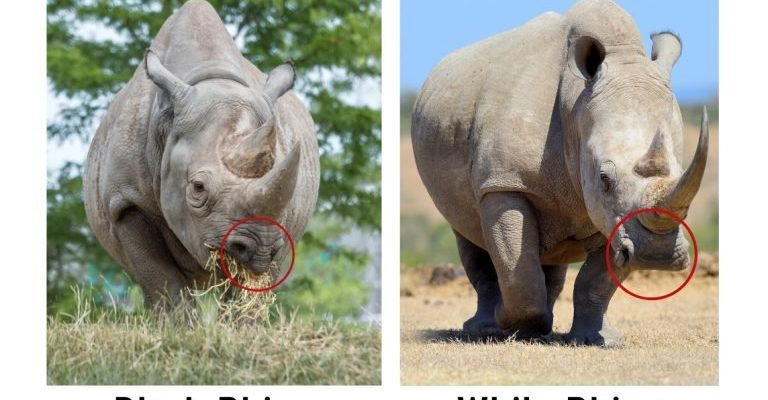![Comparing The White Rhinoceros Vs. [Similar Species]](https://gudri.com/wp-content/uploads/2025/06/Comparing_The_White_Rhinoceros_Vs___Similar_Species__image_0.jpg)
In this article, we’ll dive deep into the characteristics, behaviors, habitats, and conservation status of these two fascinating species. If you’ve ever wondered how they compare, you’re in for a treat. Grab your coffee, and let’s unpack the world of rhinos!
Physical Characteristics
The physical appearance of the White Rhinoceros and Indian Rhinoceros is one of the most striking aspects of their identity. The White Rhinoceros is known for its large size, with males weighing between 2,300 to 2,900 pounds and standing about 5 to 6 feet tall at the shoulder. They have a broad, square-shaped mouth, which is adapted for grazing on grasses. Their skin appears thick and gray, almost like armor plating, allowing them to withstand environmental challenges.
On the other hand, the Indian Rhinoceros, also known as the one-horned rhinoceros, is a bit smaller but equally impressive. Males weigh around 1,800 to 2,200 pounds and stand about 5 to 6 feet tall. What really sets them apart is their unique body structure. They have a single horn that can grow up to 10 inches long, and their skin has less of a smooth texture, appearing more like plates, which makes it look almost prehistoric.
Habitat and Distribution
When it comes to habitat, these two species have distinct preferences. The White Rhinoceros primarily resides in grassland savannas and open woodlands, mainly in southern Africa. This species is often found in countries like South Africa, Namibia, Zimbabwe, and Kenya. The wide-open spaces allow them to graze and roam freely, which is crucial for their dietary needs.
Conversely, the Indian Rhinoceros thrives in the dense forests and grasslands of the Indian subcontinent. They are commonly found in national parks and reserves in India and Nepal. Their preferred habitats are rich in tall grass and occasional patches of forest, which provide cover from predators and harsh weather. The lush greenery not only supports their diet but also offers a sanctuary for nurturing their young.
Behavior and Social Structure
Behaviorally, these two rhino species exhibit interesting differences. The White Rhinoceros tends to be more social. They often form groups, particularly females and their young. These groups can sometimes consist of up to 14 individuals, which helps them protect against predators. You might spot them grazing together, enjoying each other’s company while keeping a watchful eye out for danger.
In contrast, the Indian Rhinoceros is generally more solitary. Males are known to be territorial and may defend their space aggressively. They often venture out alone, although females can sometimes be seen with their calves. Their solitary nature reflects their need for large personal areas to graze and roam, especially since food sources can be sparse in their forest habitats.
Diet and Feeding Habits
Diet is another area where these rhinos differ. The White Rhinoceros is a grazer, primarily feeding on short grasses. Their square mouths are perfectly designed for this purpose. You might find them in open fields, munching peacefully on the grass. In fact, they can consume up to 120 pounds of grass in a single day!
On the other hand, the Indian Rhinoceros has a more varied diet. While they eat grasses as well, they also consume leaves, fruits, and shrubs. Their hook-shaped lip helps them grasp and pull leaves from trees and bushes, making them more adaptable to their environment. This diet reflects their role in the ecosystem, as they help maintain the balance of the vegetation in their habitats.
Conservation Status
Conservation is crucial for both species, as they face significant threats from poaching and habitat loss. The White Rhinoceros is currently classified as “Near Threatened” with two subspecies: the Southern White Rhinoceros, which is doing relatively well due to conservation efforts, and the critically endangered Northern White Rhinoceros, which has only two living individuals left. This situation is alarming, as it highlights the urgent need for continued protection.
Conversely, the Indian Rhinoceros is listed as “Vulnerable.” Thanks to dedicated conservation programs, their numbers are slowly increasing. Conservation efforts include habitat protection, anti-poaching measures, and community engagement, helping to educate local populations about the importance of preserving these magnificent creatures.
Understanding the differences between the White Rhinoceros and the Indian Rhinoceros isn’t just academic; it’s essential for their conservation. The survival of these species shapes the ecosystems they inhabit and reflects broader environmental health. Every rhino species plays a vital role, from helping manage grassy areas to maintaining biodiversity in their habitats.
As we learn more about these gentle giants, we can better appreciate their uniqueness and advocate for their protection. Whether enjoying their presence in documentaries or supporting conservation efforts, every little bit helps in ensuring these incredible animals thrive for future generations. So, next time you think of rhinos, remember the important differences that make each species special!

